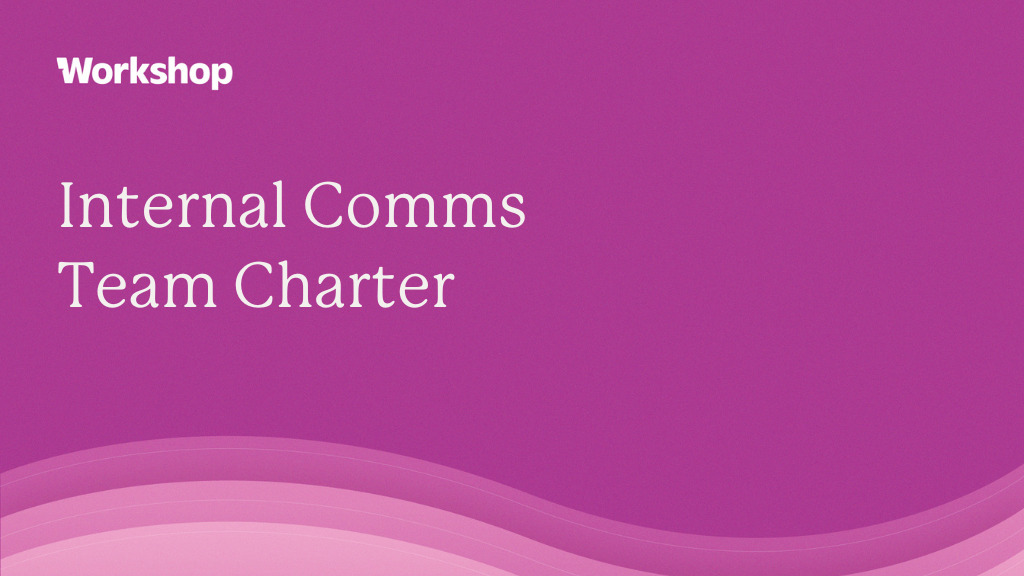Crafting an effective team charter (+ a free template!)

When it comes to teamwork, having a clear roadmap to encourage collaboration, transparency, and engagement is essential for any successful team! A team charter is a perfect tool not only to help guide your team to success but also to give new members valuable information. We’re exploring the practical reasons why a team charter is essential and breaking down the key components to include to create a practical framework that will help your team work better together!
Why a team charter is important
A team charter serves as a roadmap for better collaboration, transparency, and engagement among your team members! It’s also a great tool to use for any new hires on your team. A charter can help new employees learn the values of their new team, the scope and responsibilities of their role, how other team members like to communicate, and more!
What to include in your team charter
Here’s what we like to include in our team charter:
Team purpose and mission
One of the most important sections of a team charter is defining the team’s purpose and mission. This is a great place to state why the team exists and the primary mission, and it really sets the tone for each team member so you can make sure everyone is moving in the same direction.
Team goals and objectives
We like to include specific, measurable, achievable, relevant, and time-bound (SMART) goals in this section. This helps clear any confusion so each team member can contribute effectively to the overall success of the team.
Team core values
Clearly defining core values within a team or department helps create a healthy team environment that is built on trust and understanding. Team values encourage groups to work more effectively together and can help team members align their decisions with the overall goals and purpose of the team in mind.
Team members + roles
Listing out each team member and their role in your team charter is a great way for the entire team to understand everyone’s responsibilities (and helps reduce confusion or misunderstanding when it comes to who is in charge of different tasks)! It’s also helpful for each team member to know what is expected of them and creates a sense of ownership and responsibility for success (both individually and for the team as a whole)!
Scope + key responsibilities
This section should include the main responsibilities, projects, and tasks of the team as a whole. It’s also a great place to scope outlines of what the team does and doesn’t do.
Metrics of success
We like to include the team’s main key performance indicators (KPIs) and list how to measure the success of each one! This gives the team a clear understanding of what needs to be achieved and can help align everyone’s efforts to get to the goal. It’s also a great place to help manage and meet leadership and stakeholder expectations! When metrics of success are agreed upon, and the team meets those expectations, it’s easier to get buy-in from leadership for any new tools or ideas your team is looking to implement.
Key stakeholders
Speaking of stakeholders…clearly list them out in your team charter! When stakeholders are aware and involved in a team charter, they are more likely to be invested in the team’s success!
Communication plan, work processes, and group norms
This section should outline how team members will communicate with each other and stakeholders. Include information about meetings, work processes, reporting structures, and communication tools. (PS — If you are curious about the four internal comms tools needed to help create, streamline, and track all of your efforts, we’ve done a deep dive into them here!)
It’s also a great place to include individual team members preferred forms of communication. Maybe someone prefers to communicate tasks via email or Slack – list those preferences in this section!
Strengths & skills + weaknesses & opportunities
Be sure to include a section for strengths & skills and weaknesses & opportunities! Remember, these are strengths and weaknesses of the entire team, not individual members of the team. List out what your team does well and how they contribute to the overall success of the organization, its goals, values, and mission. Then, list out the weaknesses and opportunities that your team may face. This can help your team develop strategies to minimize the impact of any potential challenges. (It also highlights opportunities for growth! Team members are more likely to seek out training opportunities to help develop new skills.)
Resources & support
Lastly, be sure to include a section for resources and support that your team can refer to (and refer to often). These could include any training documents or opportunities, collaboration tools that the team uses, project briefs, or any other places where team members can find relevant information, data, or organizational knowledge.
A few final tips to keep in mind when you are creating your team charter
- Involve the entire team: Similar to key stakeholders, when everyone on the team is involved in creating the team charter, they are more likely to be invested in the team’s success! Regularly seek their perspectives on how effective they think the charter is and use their feedback to make changes.
- Keep it dynamic: Your team will inevitably change or grow. Goals may adjust, team dynamics may change, and lessons will be learned from challenges and successes! Allow for the team charter to be a flexible document that you can update monthly or quarterly to accommodate your team’s evolving needs.
- Include team success stories: We love the idea of including a section for team success stories where you can showcase your team’s collaborative achievements! You could include quotes from other departments congratulating your team on a win or milestone. Or, highlight stories of how your team navigated challenges and the problem-solving skills they used. Consider storing all of these stories in a folder on Google Drive so your entire team can access them if they ever need a boost. We’ve seen people refer to these folders by a few different names– a kudos, praise, or compliments folder, among others!
Now that you have a detailed guide on what to include, you’re all set to create a team charter that perfectly fits your organization’s goals and values. But you won’t have to start from scratch! We’ve put together a customizable team charter template for you. It’s a practical starting point to encourage great collaboration and guide your team to success. Grab your copy here!








